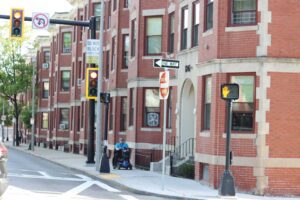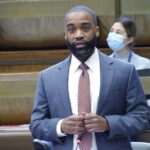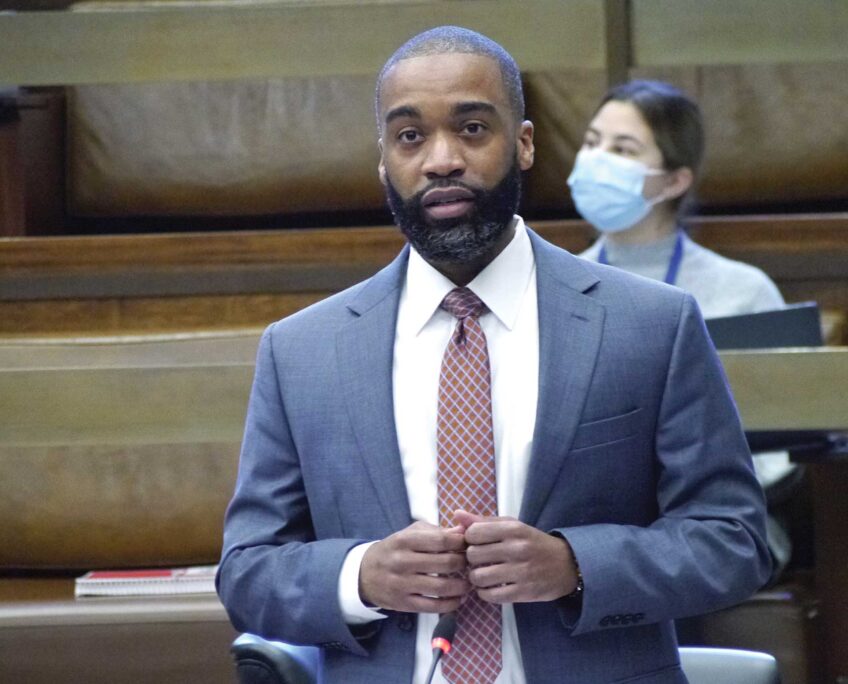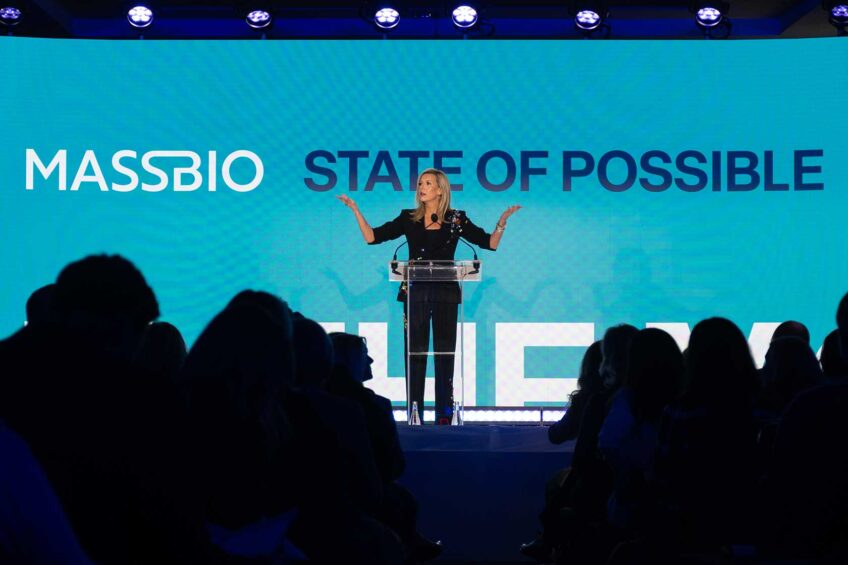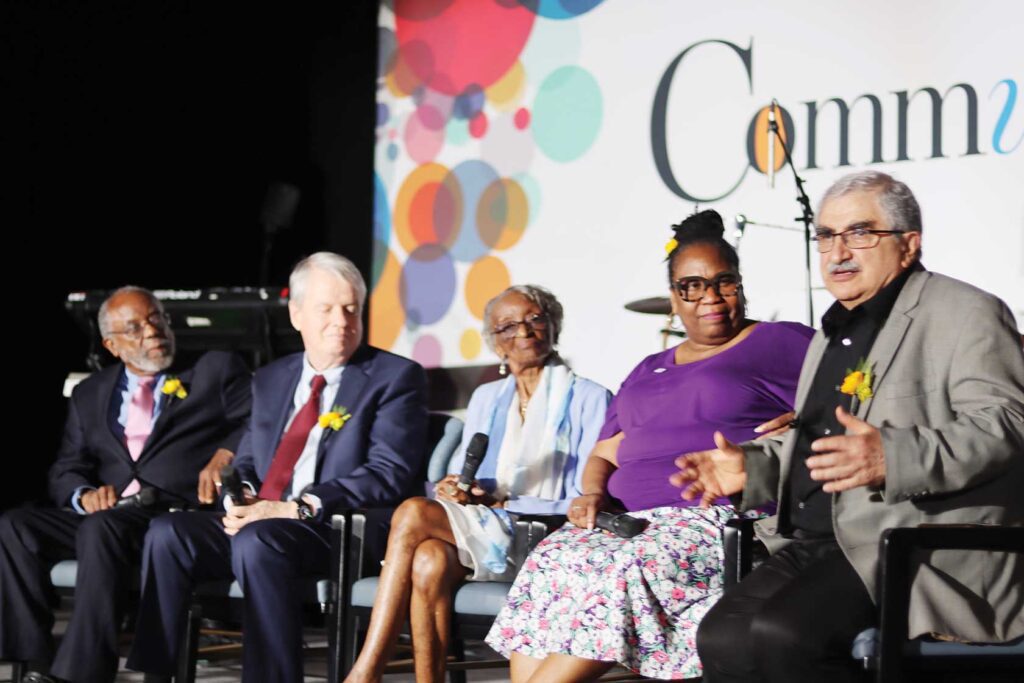
When the Southwest Expressway plans collapsed in the early 1970s, the corridor between Roxbury and Jamaica Plain was already scarred. Decades of diligence by Urban Edge, an affordable homebuilder, have been healing the divide.
Last week, Urban Edge celebrated its 50th anniversary in downtown Boston and honored some of the legends of rebuilding the urban fringe, including the organization’s founder, Ron Hafer, who died last December.
Looking ahead, Urban Edge’s stakeholders see a challenging landscape for affordable housing construction and surging demand. They remain confident that their organization is prepared.
Bracketed by elevated Orange Line tracks and a railroad embankment, Egleston Square had been neglected for over a decade before Urban Edge.
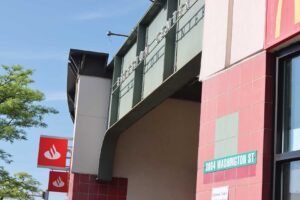
Urban Edge redeveloped Egleston Center with an architectural homage to the MBTA. PHOTO: PETER C. ROBY
A line through the community on a 1961 map discouraged investment. Resigned to eminent domain, homeowners squeezed out a profit. Some collected insurance checks after convenient fires.
Into this hollowed outskirt, Hafer and the Ecumenical Social Action Committee dedicated time and labor, rallying allies into the effort.
Ellen Hafer, Ron’s widow, said her husband’s vision had been “supporting people who were trying to buy homes.” Calling this urban homesteading, Hafer’s nonprofit had two services: brokerage and rehab.
Established in 1974, Urban Edge’s first listing in the Boston Globe ran in February of the following year. It started in a small office on Centre Street in Jamaica Plain. After board meetings, directors got their hands dirty landscaping rehab properties.
Initially, Urban Edge was a last resort to teardowns. Taking ownership of deteriorating homes from the city of Boston, estate sales or foreclosure, Urban Edge got them ready for resale. Buyers who agreed to renovate, paint, landscape or demolish earned “sweat equity,” reducing down payments.
Houses proximate to transportation and parks listed for under $20,000. But Urban Edge also brokered valuable listings across Boston and in Brookline.
Ellen Hafer said Ron Hafer would personally introduce bank presidents to potential buyers, vouching for their credibility. She called this “hand holding, confidence building.” It made a difference.
She emphasized Urban Edge’s “community concept” as critical to success. “People bonded,” she said. “They didn’t leave; they didn’t give up.”
Across the Charles, Hafer’s successor, Mossik Hacobian, was renovating abandoned buildings in East Boston. An architecture major at Columbia, Hacobian moved to Boston as a conscientious objector.
In 1977, Urban Edge hired Hacobian as a rehab specialist to replace construction manager John Rowse. Joining a team of “five or six,” Hacobian said, he worked out of a “satellite office in … whatever house we were renovating.” He used a piece of plywood over two sawhorses for a desk.
As business grew through the 1980s, Urban Edge relocated to what is now the Father Jack Roussin Community Center, a building Urban Edge renovated in 1992. An earlier rehab attempt was cut short by a fire in 1983, so Urban Edge moved temporarily to the “brewery building of JPNDC” Hacobian said.
At that time, Hacobian was waging a multi-year push to reclaim the Dimock-Bragdon apartments. Starting in 1977, resident cleanups at the site showed that people cared.
Hacobian compared Columbus Ave to a “Berlin Wall” between JP and Roxbury before Urban Edge got involved. As a “burned out shell at one end” with “everything boarded up,” Dimock-Bragdon depressed the neighborhood.
“Ron’s idea,” he continued, “was that we needed to knit the neighborhoods together” from Jackson to Egleston and Hyde squares.
Completed in 1984, the rehabbed Dimock-Bragdon marked a transition out of the brokerage field, which was newly competitive, into complex management.
Early success allowed Urban Edge to take on larger projects, but posed a dilemma: New homeowners could sell into an improving market, undermining chances of long-term neighborhood affordability.
Urban Edge pursued creative solutions. In its large apartments, tenants have a 50-50 ownership stake, a model Hacobian likened to land trusts.
“We used every mechanism possible,” he said, “homeownership, 50-50 partnership with residents, condominiums and cooperatives.”
Susan Curry, a 40-year resident of the Theroch apartments near Franklin Park, celebrated Urban Edge’s first five decades last week. As president of the tenants’ oversight board, she spoke about the joy of working with Urban Edge.
Surrounded by children and grandchildren, Curry said the CDC’s next 50 years would offer young people hope.
Emilio Dorcely, CEO since 2019, said as “the affordable housing industry professionalized, so did Urban Edge.” He credits Hacobian with shaping Urban Edge’s work presently. His successor, Chrystal Kornegay, “set us on the course of long term sustainability.” Kornegay runs MassHousing today.
Dorcely speaks of meeting the moment. Vacancies or abandoned homes aren’t as plentiful as in 1974, limiting the low-hanging fruit, but funding streams are more consistent.
Phillip Clay bought a home on Sigourney Street from Urban Edge’s brokerage. He moved to Boston when Cambridge had become unaffordable and joined the board.
Clay said that in 1974, “The banks wouldn’t lend” if homes might be torn down or in neighborhoods where home values declined, and redlining was another factor within and “beyond the corridor.”
In the 1980s, Boston Housing Partnership “included major bankers, public agencies, foundations” working together to “save Boston housing,” Clay said. It started with about 800 units citywide.
Mossik said that partnership enabled Urban Edge to renovate 82 apartments over a few years. BHP has since merged into Metro Housing Boston.
He said that banks should reinvest in their deposit base. But, vanity mattered. Expanding globally, they couldn’t have headquarters amid decay.
Now, Clay said, “the city and state are committed” to funding affordable housing “for the foreseeable future.” The federal government, though, is “not a major player now” outside of public housing and recapitalizing expiring use contracts.
John Couples, a Jamaica Plain resident since 1970 and Urban Edge incorporator, said today’s surging housing prices present “a different kind of problem.”
Affordable housing, he said, is built with “an extractive financing model” that “works against nonprofit developers.” Buyers of tax credits benefit most. Couples also argues that zoning “reinforces stratification.”
Tax credits, said Dorcely, are the most important funding source. But, they work best for bigger projects of 25 units or more.
He estimated Massachusetts has a shortage of 200,000 affordable housing units.
“Every unit represents a life and a family,” said the civic leader. “Affordable housing is the foundation” on which social change rests, and students struggle to learn without “a safe place to rest their head at night and to do their homework,” he said.
“We need to ring the alarm,” he said, while crediting the policies of Boston’s mayor, Massachusetts’ governor and the General Court. He hopes to see a transfer fee in the Affordable Homes Act advance. Boston needs it, he said.
He also advocates both rent stabilization and homeownership opportunities, backed up by resident input to the Roxbury Collective.
Dorcely highlighted progress on hundreds of new units at the Mildred Hailey campus in six different buildings. Urban Edge will finish construction at 1599 Columbus Ave. in the fall.
With strong ties to JPNDC and The Community Builders, Urban Edge remains open to evaluating partnerships with other CDCs.

